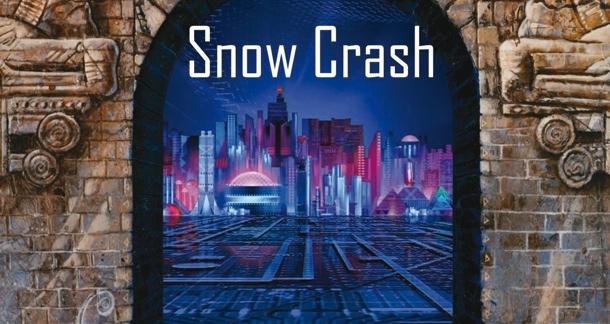
by Ben Zackheim | Jul 30, 2015 | Book Promotion, Sell your book |
This is either a “No duh, Ben” post or a “Holy cow, that’s cool!” post. I was playing around with Facebook search the other day and found it to be much more useful than I thought. There may be a buried tool in there to help people find you and buy your book…
I typed in the name of a friend of mine to see what he’d been posting recently. I usually see much more chatter from him and I was worried about his Facebook silence. He’s also a fan of my work and we share a love of Fantasy books that will keep us close, even in the afterlife (where I’m sure our perspectives on Fantasy will likely change).
Well, I found that he’d been posting as often as ever but Facebook decided to show me less of his life. Thanks Zuckerberg!
But I noticed something cool in my friend’s Interests column. He’d recently liked Snow Crash (he’s slow sometimes) and it got me thinking.
Can I search for all of my friends who like Snow Crash?
I typed “Friends who like Snow Crash” in the field and, boom, got a list of friends who like Snow Crash. Okay, maybe that makes sense to you. Facebook is, after all, a social network!
But then I typed “Friends of my friends who like Snow Crash” and you know what? I got a list of people, most of whom I don’t know, who like Snow Crash.
How is this useful?
Well, imagine that you’re targeting lovers of Snow Crash in your marketing efforts. Now imagine you could compile a list of people who may be interested in your book and they’re a free nudge away from giving your book a shot. All you have to do is let your direct friend know that you think their friend may be interested in your work and ask them to call out their buddy in a FB post.
So this is how it would work:
1) Determine what books your book is similar to.
2) Search for friends of friends (FoF) who like each of these books.
3) Make a list of FoFs, who your mutual friend is, and which book the FoF likes.
4) On launch day, announce your book and then ask the friends with FoFs to comment on your launch post with a direct call-out like: “Hey [FoF name] I think you may enjoy this book. It’s like [Name of similar book that the FoF likes].”
Yes, you could spend a few bucks to reach the same person but they’re more likely to respond to a recommendation by a friend instead of a sponsored post in their feed.
Mind you, I haven’t tried this myself but it seems like a no-brainer way to get the word out about your book.
What do you think?

by Ben Zackheim | May 29, 2014 | Digital Identity, Writing |
NOTE: In the coming months I’m going to write about how we present ourselves online. Digital ID, as I call it, is the sum of:
After two decades of doing business online, I’ve realized that we must know who we are offline to establish the strongest Digital ID. I’ll set out to prove that thesis in my articles.
We’re all learning how to maneuver this wonderful, liberating mess together! So I look forward to hearing this community’s opinions.
—
I like the image above because it’s how I feel when I wake up in the morning and put on my marketing cap and get on Facebook. I feel like I’m immersed in a pool of people, some of us connected, some of us not, some of us wanting to be connected, some of us not. And I think it’s important to recognize that mess. I think understanding how messy things are makes it easier to understand how we feel about establishing a digital ID. And, just as importantly, what we need to do to set up our own Digital ID.
What do I mean by that?
Here’s my best explanation: I’m a strong believer in the independent storyteller’s power. Not just the power of moving people to think and act and feel, but the power to find an audience on your own that you can tell your story to.
The Slow, Agonizing, Delightful Death of the Gatekeeper
For a long time, storytellers have been ruled by gatekeepers who got to tell us, “That story is good enough and worth this much. But that one sucks and good luck!”
Those days are coming to an end.
And how do I know this?
Because I was a gatekeeper.
I told some brilliant people that their stuff wouldn’t make it in today’s market. Sometimes I was right, sometimes wrong. But the powerful emotions I felt when I saw some of them move on and do great things were undeniable.
I wasn’t regretful.
I wasn’t envious.
I was inspired.
I saw them leveraging brand new tools, online services, ways of connecting that no one had thought of. They found their audience without Viacom, ESPN, AOL, Sony and all those other places where I worked.
Those gatekeepers were wrong.
I was wrong.
For my part, I had enough confidence in my own writing talent to strike out and try this new world on for size myself.
Now, the jury is still out on whether that was a good idea. While I’m doing great, I’m not making a living wage at writing my books. But I like the trajectory and I love the process. The freedom is exhilarating.
And it’s messy. Like this post’s image.
So what does this mean for working artists?
We’re living through a fundamental shift in how people learn about us and how we learn about them. As a writer looking for an audience I know in my heart that I’ll find my readers only if I stay true to myself.
To be clear, I find the incredibly detailed tracking of people by big companies creepy. I don’t trust them with the information. The counterpoint is that most of them are sharing that data with everyone. Some charge (like FB) and some don’t (like Google). Does that make it okay? I don’t know the answer to that.
I do know that I can go online and have a universe of data on my target audience at my fingertips. If I work hard, stay true to myself and my work, I can reach them and I can make a living telling my stories. The sacrifice I make is that my interests, preferences, friends and behavior is also thrown into this messy pool of data — slicing my identity into little pieces for another artist or writer or entrepreneur to scour through and evaluate.
[Tweet "I'm a data point for someone else. And they're mine."]
It’s a fascinating, liberating, terrifying time. And I’m delighted to be a part of the mess every single day.

by Ben Zackheim | Mar 26, 2014 | Book Promotion, Writing |
Goodreads giveaways are a wonderful way for authors to reach potential readers. Why? Because when you give away your book on Goodreads, you’re placing all of your hard work in the hands of someone who wants your book and wants to enjoy it. That last part of the sentence is important. Everyone knows that Goodreads is filled with readers. But one of the unspoken benefits of Goodreads is that people on the site are predominantly kind and supportive. Yes, there are exceptions. But people want to enjoy the books they read. This means you’ll find readers and they’ll be on your side from the get-go.
When you give away a book it’s different than giving away an app, for instance. Books speak to our hearts, minds, senses, emotions. By giving away our story we’re already ahead of the mad rush for people’s hearts that other businesses strive for.
The second biggest benefit of Goodreads giveaways is powerful. If you’re giving away a pre-release book, Goodreads will email many of the contest entrants with news of your book launch. More on that below.
Before you can tackle any of the steps here, you’ll need to sign up to be a Goodreads Author.

This requires you to have a book in their system. You can add your book easily. Just make a simple request to a Goodreads Librarian.
So once you’re an author with work on the site, here’s how you set up Goodreads giveaways:
1) Go to www.goodreads.com and sign up or sign in
2) Click on Explore in the upper right. Then select “giveaways”.
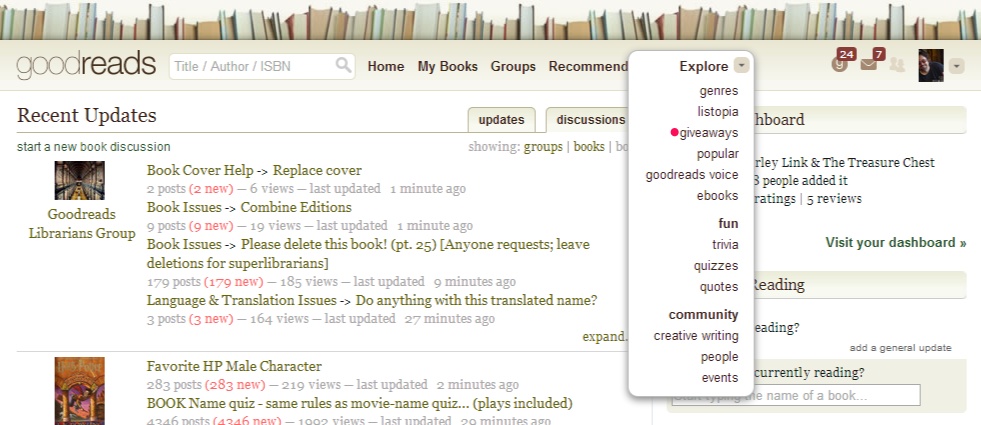
3) You’ll see a list of current giveaways. If you’ve signed up as a Goodreads Author you’ll see “List a Giveaway”. Select it.
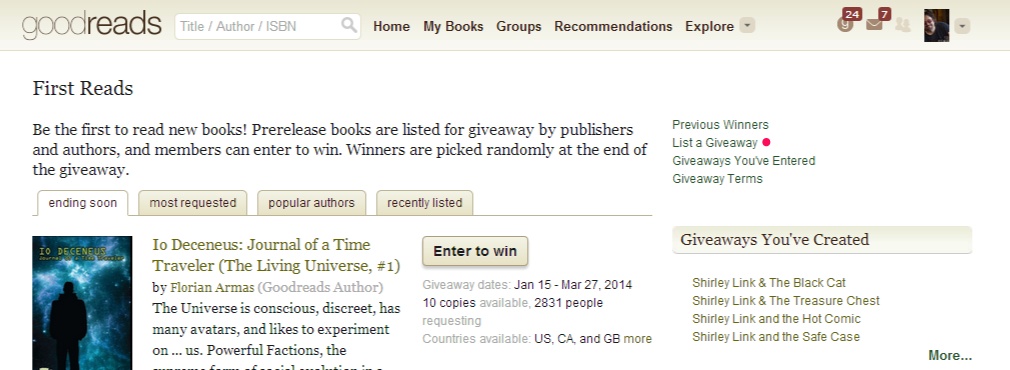
4) Here’s the listing page at last!
Look below the image to get the run-down.

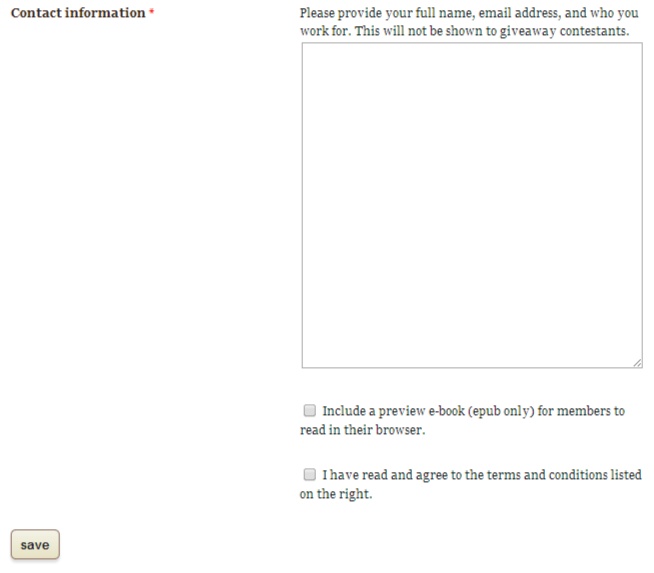
The “gotchas” and best practices are as follows:
-
Be sure to make the contest last a full month. Any less and you’re missing out on potential readers. In general, you’ll see the hugest spike in entrants as the contest deadline approaches, so fret not if things start slow!
-
Try to do the contest a full 2 months before the book launch. So when the contest ends you’ll still have a month to get feedback and reviews from your winners. And they’ll feel special that they got a book a month before it came out.
-
Enter your ISBN or ISBN13 in the field. If you only have an ASIN (Amazon’s ID format) then click on the “Switch to Book ID” link on the right side of the text entry field.
-
Make the description a kick-ass, direct pitch. The better the description, the more entrants you’ll get, guaranteed.
-
Goodreads likes to have authors give away 50 books. I agree that it’s a good number if you can afford it. I’ve done 10 and been happy with the results. However, I plan on following their advice with my next giveaway for The Camelot Kids. 50 copies, here I come!
-
If you don’t have a publisher then just enter your own site’s url. If you don’t have a site, please build one.
-
Choose the countries where you think your book will resonate. It’s a pain to send books internationally, but worth it if you can grow your global readership.
-
Tags are a whole post unto themselves. Enter terms that you believe apply to your book. You can use genre terms (horror, scifi), popular terms (Sherlock, Chicago Bears) or whatever comes to mind. The tags will help entrants choose the book that’s right for them.
-
The contact info is just asking you for basic info. Don’t worry about it. Just write something like “[Name], [email]. I’m the author of the book, [book name]
-
You can include an excerpt of your book for entrants to read. I’d advise doing this because the more people who enter who really WANT to win your book, the better your buzz will be.
Agree to the terms. They’re perfectly reasonable. Here they are for your convenience:
-
You agree to supply the indicated number of books on the date the giveaway ends.
-
Goodreads will list (for free) the giveaway book on the giveaways page.
-
Goodreads will collect interest in the book, and select winners at our discretion. Our algorithm uses member data to match interested members with each book.
-
After the giveaway stop date, click the name of your giveaway (listed under “your giveaways” on the main First Reads page) to see the list of winning addresses. You will also be emailed a list of winners. You are responsible for shipment of the books. Failure to do so will result in us not inviting you over for cake ever again.
-
You agree not to store the winners’ mailing addresses and not to use the winners’ addresses for anything other than sending them the indicated book.
-
Winning members are encouraged but not required to write a review of the book they receive.
-
Ebooks are not allowed. Every winner must receive a physical copy of the book.
Once you’ve started the contest you can retrace Steps 1-3. Notice the area on the right-hand side of the page that reads “Giveaways You’ve Created”? That will give you quick access. You can also find the contest listed on your Goodreads Dashboard
Now here’s the wonderful part. Everyone who enters your Goodreads giveaway will be opted-in to receive an email from Goodreads on the release date. That’s why they ask for the launch date of your book on the form above! In my experience about 75% of the entrants stay opted in.
That’s it! Now you need to promote the contest. That includes posting the Goodreads giveaway on linky (contest) sites and, yes, leveraging Goodreads advertising. I’ll post about that soon.
The final bit of usefulness comes from Goodreads itself. This slideshow is gold.
You might also find the following posts useful:
Does advertising on Goodreads work?
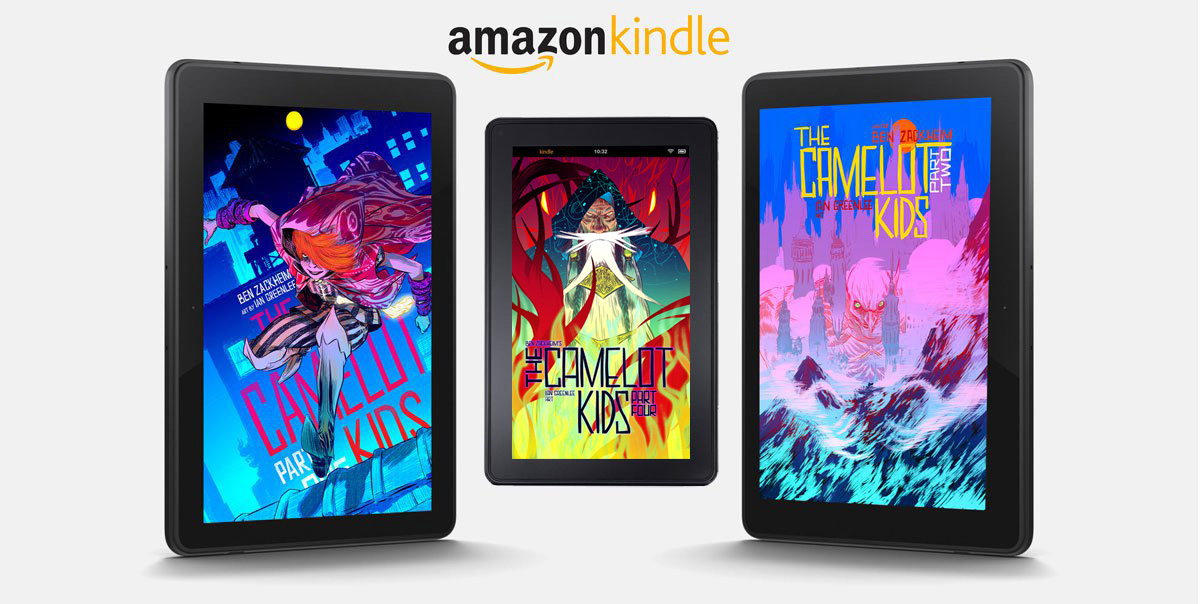
by Ben Zackheim | Feb 19, 2014 | Book Promotion, Writing |
A step-by-step guide, with best practices!
Yup. Blog posts about Amazon KDP Select free promo days are as common as bad drivers on I84.
But I want to do something a little different here. I want to lay out steps and include details about why they are important. I’ll also give you a basic overview of boosting posts on Facebook. These days it’s best to spend five bucks to get the word out.
Once you sign up for KDP Select and figure out what you can do with your exclusive Amazon ebook, you may find a small bump in the road. Actually it may look more like a big, honking wall. The wall is spray painted with large words…
“Now what?”
Here’s what.
1) Decide why you’re doing the KDP Select free promotion days. Don’t just do it to see what happens. I can tell you what happens. Lots of people download your book and add it to their vast library. That plus $17 will buy you a coffee.
Here are some great reasons to do a free giveaway that will actually add some momentum to your efforts:
-
You want the reader to buy the next book in the series. Provide a sample of the next book in the back of the book you’ll be promoting. Provide a link to buy the next book too. If you haven’t done this already, it’s a good idea.
-
You want the reader to buy another book you wrote that is not in the series. Same as above.
-
You want newsletter sign-ups. Definitely recommended if you don’t have any other books available to buy, because this way you minimize the risk of losing them before your next book comes out. People forget things. Even authors they enjoy.
-
You want reviews. Make a level-headed case at the back of the book for writing a review. I lifted my copy from David Gaughran:
“Word-of-mouth is crucial for any author to succeed. If you enjoyed the book, please leave a review on Amazon. Even if it’s just a sentence or two. It would make all the difference and would be very much appreciated: [link to book on Amazon]”
For your first promo I don’t believe you should shoot for more than one of the above goals. Why? It’s hard enough to track progress on one front, much less several. You can always adjust your tactics for the next free promo.
Once you’ve chosen your general goal, choose a specific one. Are you going for sales of the next book in the series? Great! How many do you want to sell? Just guess. Set a goal and be ready for failure or success. Both can be daunting, but it’s essential to measuring the success of your effort.
2) Decide how many days you want the free promo to run. I suggest a minimum of two. This way you can spot whether downloads are accelerating over a substantial period of time (implying a hunger for your book and/or wise choices on the marketing front) or not (implying you’ve missed the mark on marketing).
My opinion is that five days is too long. Especially if this is your only book. Why is that? Because free promo days are a great way to get people to give you a try. If you don’t have another book to sell them then you’ve lost them.
Also, five days is too long because you don’t want everyone who WOULD download your book to see it and download it. You want to leave some room for word of mouth to set in. The longer you keep the book free, the more likely you are to exhaust your potential audience in one go. Now, if you want to just get maximum exposure then five days is an option. Just don’t expect too many sales after the five days is over. You’ve gotten on their Kindle, and now you have to hope they convert to other books in the series or other titles you’ve written.
3) Buy one guaranteed spot. If you can avoid it, do not choose a date for the promo days first. Please. Choosing the date first means you’re setting something in stone before you know the availability of your marketing options (i.e. Bookbub, Bookgoodies, etc.)
So first, choose one of these sites to buy a guaranteed spot.
Bookbub
Booksends (formerly Bookblast)
Free Kindle Books and Tips
BookGoodies
AskDavid
Manybooks
These are the top-notch options for your free day advertising. Choose one, secure a date, and then choose more from this category if you can afford it, and if they can accommodate your dates. Bookbub is tough to get on. They may turn down your money. But one or two of these sites will be happy to take that heavy dough off your hands. I’ve had an especially impressive result from Manybooks. Shirley Link & The Safe Case hit the top 500 Free list on Amazon and it took four days to settle down. Highly recommended.
4) Make a list of friends you can count on to share and bug ’em. Prep an email to them. You’ll send it out a day or two before the promo.
Dear friends!
I apologize for the group email but I want to reach as many people as possible for this. I’ll be giving my ebook [book name] away for FREE on [date]! Why free? It’s a limited time deal on Amazon that will expand my readership and give me a chance to find some new fans.
I could use your help on the promo day. Please keep an eye on [Facebook, Twitter]. When you see my announcement, please Like and Share. The sharing part is important since it will help more people see the deal.
That’s it! I appreciate any help you can provide to get the word out. I’ll let you know how it goes!
Sincerely,
5) Tell the following sites about your KDP Select free promotion days. Be sure to track who you’ve told in your app of choice. I use my Google Docs marketing journal (which I’ll write about one day)
Best websites for marketing your Amazon KDP Select free days
You can also use the Author Marketing Club tool to submit. The tool is a little wonky but it works.
6) Now head in and set your free days on Amazon’s KDP Select site.
7) Now go to your social networks of choice.
Twitter. If you have a Twitter Ads account then you can schedule tweets to go out whenever you want. If you don’t have a Twitter Ads account, it’s worth it. It’s free and gives you incredible stats and some useful features. Sign up for Twitter Ads here. (it’s a Twitter-owned service) Some people use Hootsuite or Buffer to queue up their tweets for later. Both are excellent options. Set up seven tweets per day of your promo. Don’t make them all sales pitches. Make them intriguing.
-
Write a riddle.
-
Include an excerpt.
-
Ask a compelling question that your book answers (fiction or non-fiction).
-
Include pics (cover, interiors).
-
Include vids.
-
Include every media you have for your book!
I recommend you buy some ads on Twitter Ads to get the word out. But wait until the next promo. For your first promo, give Facebook some hard-earned cash. They’re getting good at delivering readers to me.
Facebook. Do two posts for each day of the promo. Again, set these posts up ahead of time. You should consider boosting your posts with a $5 spend. It increases awareness of your promo. Just make sure you target correctly and set the post date for the promo date. How do you do that? It’s easy.
Draft your post (please include an image of the book cover to make the post appear nice).
Then click on the Boost Post button at the bottom of the post window.
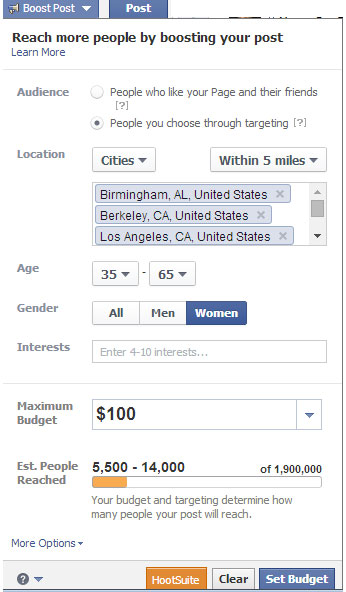
Notice the elegant layout. Amazing how Facebook can make great interfaces when money’s involved, huh?
NOTE: Facebook changes their design all the time. The boosting process will always be similar, though.
Just select “People you choose through targeting” to get the range of options you’ll need. Then fill out information that you think appeals to your target audience. The Interests window is especially important. Put words in there that relate to your genre and book. So if you wrote a book inspired by “It” you could enter “horror, stephen king, violent, scary clowns, it.” Yes, you can get as specific as you’d like. The more specific, the better. With these data in place a whole slew of people who are interested in King, It, and scary clowns will get your ad served to their page.
Some people don’t get great results with Boosts and prefer running Facebook ads. These show up as promoted posts in the feeds of people who you target. The process of setting up an ad is more complex, but you can get the lowdown on how to do it here. If you want to take a course in Facebook ads, sign up for this course.
Pinterest. Post your cover art, interior art and marketing images. The copy should tout the free promo days.
7.1) Add a keyword. Thanks to Julia Derek in the comments section, you get this excellent tip. A couple of days before the promo, head into KDP and add the term “free ebook” to the book’s keywords. It will take several hours to a couple of days to go live. This should help people find you if they’re looking for free ebooks. Don’t forget to remove the keyword term after the promo is over, though.
8) On the first morning of your KDP Select free promotion days, monitor! Go to your marketing journal and see which sites you informed of the free days. Did they post the promo? Not all of them will. Be aware that some sites will post at the end of your day (it’s a big world!) Take note of which ones posted. You’ll want to have that list handy for the next promo.
Go to the site(s) where you paid for promotion and make sure you got what you paid for.
Post the deal to these promotional sites. They only accept additions on the day of the promo.
Addicted to eBooks
Snicks List
Send out an email to your friends, reminding them and offering some new details/news that will make the email worth a read.
Hi all!
As I mentioned, my ebook is free for today on Amazon! Please share the post on your timeline. If you don’t see it, here’s the url.
[insert url for shared post, tweet, etc.]
Thanks so much! I checked my dashboard and have [number] downloads so far. So excited.
Sincerely,
If you’re happy with the results you can post about your success on social networks. It might be nice to send a final email with the good news if you feel like that’s a good idea.
And, of course, head to Amazon KDP to check on the progress. Watch the downloads roll in! It’s fun. Don’t forget to eat.
9) If downloads accelerate on day two, consider adding another day to your promo. Increased interest in your book over a 48 hour period may be a sign that you’ve broken through to a larger audience than your genre warrants. In other words you may have broken into Amazon’s “mainstream” a little bit. If this happens then adding a day will allow for you to capture a much wider audience. Ideally, you’ll go back to charging for the book right when the interest peaks. This way you’ll pick up sales from people who were interested enough to pay for your book.
10) Was it a success? You should keep promoting for a few days after the promo is over. Tout your rise in the rankings, new reviews or whatever stands out as a positive result. But also evaluate the performance of your campaign. Remember how you set a specific goal for your promo? Did you meet it? Exceed it? Give the readers a couple of weeks to show their intent. It takes a while to read a book for some of us!
Take a realistic look at your results. Gauge what went right and wrong with the promo (you will see what worked and what failed). Write these down. Don’t assume you’ll remember because you might not, which means you learned nothing. With all this data, draft a plan for the next promo. And congratulations! You’re on the road to getting much better and being more comfy with marketing! No small task, friends.
Let me know how your promo goes.
[jetpack_subscription_form]
You may also like:
Amazon has a bridge to sell ya!
The $1.1 Million question: Is KDP Select worth it?
by Ben Zackheim

by Ben Zackheim | Aug 6, 2013 | Book Promotion, Writing |
I talk to a lot of writers, and one of the most common questions I get is, “what can Goodreads do for me?”
The answer is, “Goodreads is good for creating interest around everything that has to do with books”. As a reader, a writer, or a reviewer you can lose yourself in Goodreads if you plow through the horrible interface and abandon yourself to it. I’ve been a member since January, 2012 and I’ve only skimmed the surface. But one feature (besides ads) that I’ve benefited from over time is the Goodreads giveaways feature.
After running a number of Goodreads giveaways I want to help dispel any confusion about why or when to run them (I’ll do ‘how’ in another post). As an author I’ve had hundreds of people add my books to their shelves using contests. It’s worth every minute I’ve invested.
Okay, so the most frequently asked questions are:
1) What are the Goodreads giveaways good for?
Simple. They get your book in front of hundreds, or even thousands of people. And not just any people, READING PEOPLE. Our favorite people.
When a reader enters the contest they are opted-in to add your book to their Goodreads shelves. That means most entrants will have your book added when they enter. So what? you may ask. The big deal here is that if your book is not released yet then everyone who added the book to their shelves will receive an email when your book arrives! Let me repeat that, if you are promoting a book by doing a giveaway on Goodreads, and the book is pre-release, everyone who adds your book to their shelves while entering your contest will receive a launch email from Goodreads.
Yeah, it’s awesome.
2) Can I run a contest for a book that I’ve already released?
Yup, and it will definitely help you get exposure, too. The downside is that there will be no launch email sent out by Goodreads since your book is already out there. But you will get on a bunch of shelves and you’ll be able to get reviews, plus some new friends to follow your Goodreads status and event updates.
3) How can I maximize success?
Two things, run the contest for one month. This gives it time to find traction. Two, advertise the giveaway on Goodreads. This will give you the best chance to find people who are interested in books like yours.

If you’re doing a giveaway for a pre-release, then do your first contest 3-5 months before launch to build buzz. You’ll need to give away proofs, because, well the book isn’t out yet! Also important to note, you cannot give away ebooks at this time.
I hope this clears up any confusion about what Goodreads giveaways are good for. Did I do a good job of that? Let me know in the comments!
To read:
How to set up Goodreads giveaways
Don’t miss this priceless slide show presentation that Goodreads gave recently about how to promote your books on Goodreads!
Does advertising on Goodreads work?
The Ultimate Guide to Goodreads for Authors
by Ben Zackheim












